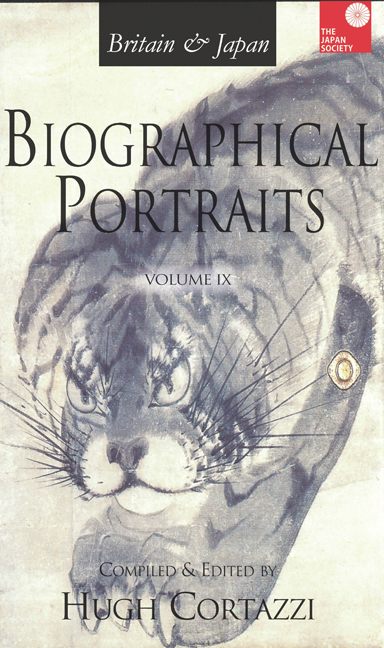Book contents
- Frontmatter
- Contents
- Introduction
- List of Contributors
- Index of Biographical Portraits in Japan Society Volumes
- PART I JAPAN IN BRITAIN: THINGS JAPANESE
- PART II BRITAIN IN JAPAN: TRADE
- BRITISH ACTIVITIES
- MISSIONARIES
- MUSIC, DRAMA AND FILM
- EPISODE
- PAINTERS
- JOURNALISTS
- JAPANESE WOMEN PIONEERS
- PART III SCHOLARS AND WRITERS: JAPANESE
- BRITISH
- PART IV POLITICIANS AND OFFICIALS: JAPANESE
- BRITISH OFFICERS
- BRITISH JUDGES AND A DIPLOMAT
- BRITISH POLITICAL FIGURES
- Index
22 - Sessue Hayakawa (1886-1973): International Film Star
Published online by Cambridge University Press: 30 April 2022
- Frontmatter
- Contents
- Introduction
- List of Contributors
- Index of Biographical Portraits in Japan Society Volumes
- PART I JAPAN IN BRITAIN: THINGS JAPANESE
- PART II BRITAIN IN JAPAN: TRADE
- BRITISH ACTIVITIES
- MISSIONARIES
- MUSIC, DRAMA AND FILM
- EPISODE
- PAINTERS
- JOURNALISTS
- JAPANESE WOMEN PIONEERS
- PART III SCHOLARS AND WRITERS: JAPANESE
- BRITISH
- PART IV POLITICIANS AND OFFICIALS: JAPANESE
- BRITISH OFFICERS
- BRITISH JUDGES AND A DIPLOMAT
- BRITISH POLITICAL FIGURES
- Index
Summary
INTRODUCTION
SESSUE HAYAKAWA was the first Japanese to become an international film star. He spent much of his life in the USA and France but he also lived in Britain between November 1923 and May 1924. During his stay he appeared at the London Coliseum and in a Royal Command Performance, made a theatrical tour in England and starred in two films. He became well known not only to British cinema fans but also to ordinary British people following his success with the film The Cheat (see below). On his arrival at Victoria Station he could not get into his Rolls Royce because the crowd of fans rushed onto the platform: the same happened in Liverpool when he arrived there on tour. His fans stalked him wherever he went in England.
EARLY LIFE
Hayakawa Kintarõ was born on 10 June 1886 as the youngest of the six children of Yoichirō , a fishing fleet owner, and Kane, in a fishing village called Senda situated at the tip of the Bōsō peninsula facing the Pacific Ocean. After attending the local primary school in 1901 he entered Kaijō School, a preparatory school for the Navy. He dreamt of one day becoming an admiral.
After graduating from middle school Hayakawa took the examinations for the Japanese navy and passed in academic subjects. Just before the physical examination he had an accident. While playing dare with his friends during the school holidays, and diving deep in the sea, he split his eardrum. He did not see a doctor immediately, as his father thought it would be weak and effeminate for a man to seek medical assistance for a ‘minor’ injury; the ruptured eardrum suppurated badly. He failed the physical test and spent the next four years in despair.
Kintarō was an impressionable young man. The suicide of Fujimura Misao, a young philosophy student, who threw himself into the Kegon Falls, was sensationally reported in popular newspapers and his death was glorified and romanticized among young people. Hayakawa's conservative father had instilled into him the concept of ritual suicide for any shameful act. One night Hayakawa entered the family warehouse with an ancestral sword, locked the door and tried to disembowel himself in front of a portrait of Admiral Tōgō.
- Type
- Chapter
- Information
- Britain & Japan Biographical Portraits Vol IX , pp. 258 - 270Publisher: Amsterdam University PressPrint publication year: 2015



